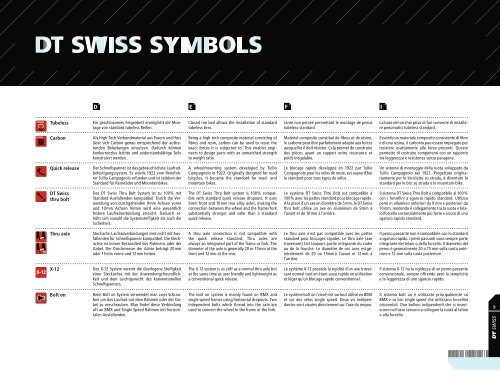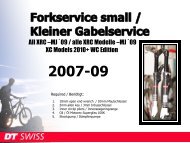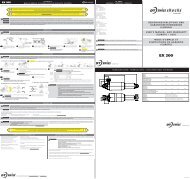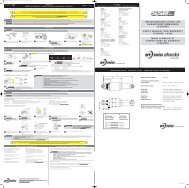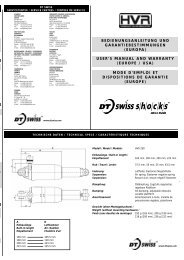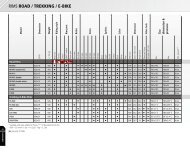You also want an ePaper? Increase the reach of your titles
YUMPU automatically turns print PDFs into web optimized ePapers that Google loves.
Tubeless Ein geschlossenes Felgenbett ermöglicht die Montage<br />
von standard tubeless Reifen.<br />
Carbon Als High-Tech Verbundmaterial aus Fasern und Harz<br />
lässt sich Carbon genau entsprechend der auftretenden<br />
Belastungen einsetzen. Dadurch können<br />
konkurrenzlos leichte und widerstandsfähige Teile<br />
konstruiert werden.<br />
Quick release Der Schnellspanner ist das gebräuchlichste Laufradbefestigungs<strong>system</strong>.<br />
Es wurde 1922 vom Rennfahrer<br />
Tullio Campagnolo erfunden und ist seitdem der<br />
Standard für Rennräder und Mountainbikes.<br />
DT Swiss<br />
thru bolt<br />
D<br />
Das DT Swiss Thru Bolt System ist zu 100% mit<br />
Standard Ausfallenden kompatibel. Durch die Verwendung<br />
von durchgehenden 9 mm Achsen vorne<br />
und 10 mm Achsen hinten wird eine wesentlich<br />
festere Laufradverbindung erreicht. Dadurch erhöht<br />
sich sowohl die Systemsteifigkeit als auch die<br />
Sicherheit.<br />
Thru axle Steckachs-Laufradverbindungen sind nicht mit Aus-<br />
fallenden für Schnellspanner kompatibel. Die Steck-<br />
achse ist immer Bestan<strong>dt</strong>eil des Rahmens oder der<br />
Gabel. Der Durchmesser der Achse beträgt 20 mm<br />
oder 15 mm vorne und 12 mm hinten.<br />
X-12 Das X-12 System vereint die überlegene Steifigkeit<br />
einer Steckachse mit der Anwendungsfreundlichkeit<br />
und dem Leichtgewicht des konventionellen<br />
Schnellspanners.<br />
Bolt on Beim Bolt on System verwendet man zwei Schrauben<br />
um das Laufrad mit dem Rahmen oder der Gabel<br />
zu verschrauben. Man findet diese Verbindung<br />
oft an BMX und Single Speed Rahmen mit horizontalen<br />
Ausfallenden.<br />
E F I<br />
Closed rim bed allows the installation of standard<br />
tubeless tires.<br />
Being a high-tech composite material consisting of<br />
fibres and resin, carbon can be used to resist the<br />
exact forces it is subjected to. This enables engineers<br />
to design parts with an unmatched strength<br />
to weight ratio.<br />
A <strong>wheel</strong>mounting <strong>system</strong> developed by Tullio<br />
Campagnolo in 1922. Originally designed for road<br />
bicycles, it became the standard for road- and<br />
mountain bikes.<br />
The DT Swiss Thru Bolt <strong>system</strong> is 100% compatible<br />
with standard quick release dropouts. It uses<br />
9 mm front and 10 mm rear alloy axles, making the<br />
connection between the <strong>wheel</strong> and the frame / fork<br />
substantially stronger and safer than a standard<br />
quick release.<br />
A thru axle connection is not compatible with<br />
the quick release standard. Thru axles are<br />
always an integrated part of the frame or fork. The<br />
diameter of the axle is generally 20 or 15 mm at the<br />
front and 12 mm at the rear.<br />
The X-12 <strong>system</strong> is as stiff as a normal thru axle but<br />
at the same time as user friendly and lightweight as<br />
a conventional quick release.<br />
The bolt on <strong>system</strong> is mainly found on BMX and<br />
single speed frames using horizontal dropouts. Two<br />
independent bolts which thread into the axle are<br />
used to connect the <strong>wheel</strong> to the frame or the fork.<br />
Jante non percée permettant le montage de pneus<br />
tubeless standard.<br />
Matériel composite constitué de fibres et de résine,<br />
le carbone peut être parfaitement adapté aux forces<br />
auxquelles il doit résister. Cela permet de construire<br />
des pièces ayant un rapport entre résistance et<br />
poids inégalable.<br />
Le blocage rapide développé en 1922 par Tullio<br />
Campagnolo pour les vélos de route, est aujourd'hui<br />
le standard pour tous types de vélos.<br />
Le système DT Swiss Thru Bolt est compatible à<br />
100% avec les pattes standard pour blocage rapide.<br />
A la place d'un axe en diamètre de 5 mm, le DT Swiss<br />
thru bolt utilise un axe en aluminium de 9 mm à<br />
l'avant et de 10 mm à l'arrière.<br />
Le thru axle n'est pas compatible avec les pattes<br />
standard pour blocages rapides. Le thru axle (axe<br />
traversant) fait toujours partie intégrante du cadre<br />
ou de la fourche. Le diamètre de ces axes est généralement<br />
de 20 ou 15mm à l'avant et 12 mm à<br />
l'arrière.<br />
Le système X-12 possède la rigidité d'un axe traversant<br />
normal tout en étant aussi rapide en utilisation<br />
et léger qu'un blocage rapide conventionnel.<br />
Le système bolt on (vissé) est surtout utilisé en BMX<br />
et sur des vélos single speed. Deux vis indépendantes<br />
sont vissées directement sur l'axe du moyeu.<br />
La base del cerchio priva di fori consente di installare<br />
pneumatici tubeless standard.<br />
Essendo un materiale composito consistente di fibre<br />
e di una resina, il carbonio puo essere impiegato per<br />
resistere esattamente alle forze presenti. Questo<br />
permette di costruire componenti con un rapporto<br />
tra leggerezza e resistenza senza paragone.<br />
Un sistema di montaggio della ruota sviluppato da<br />
Tullio Campagnolo nel 1922. Progettato originariamente<br />
per le biciclette su strada, è diventato lo<br />
standard per le bici su strada e le mountain-bike.<br />
Il sistema DT Swiss Thru Bolt è compatibile al 100 %<br />
con i forcellini a sgancio rapido standard. Utilizza<br />
perni in alluminio anteriori da 9 mm e posteriori da<br />
10 mm, rendendo il collegamento tra la ruota e telaio/forcella<br />
sostanzialmente più forte e sicuro di uno<br />
sgancio rapido standard.<br />
Il perno passante non è compatibile con lo standard<br />
a sgancio rapido. I perni passanti sono sempre parte<br />
integrante del telaio o della forcella. Il diametro del<br />
perno è generalmente 20 o 15 mm sulla ruota anteriore<br />
e 12 mm sulla ruota posteriore.<br />
Il sistema X-12 ha la rigidezza di un perno passante<br />
convenzionale, sempre offrendo però la semplicità<br />
e la leggerezza di uno sgancio rapido.<br />
Il sistema bolt on è utilizzato principalmente su<br />
BMX e su bici single speed che utilizzano forcellini<br />
orizzontali. Due bulloni indipendenti che si inseriscono<br />
nell'asse servono a collegare la ruota al telaio<br />
o alla forcella.<br />
9


